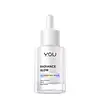What's inside
What's inside
 Key Ingredients
Key Ingredients

 Benefits
Benefits

 Concerns
Concerns

No concerns
 Ingredients Side-by-side
Ingredients Side-by-side

Water
Skin ConditioningGlycerin
HumectantButylene Glycol
HumectantPhenoxyethylparaben
AntimicrobialAllantoin
Skin ConditioningBis-PEG-18 Methyl Ether Dimethyl Silane
EmollientGlyceryl Glucoside
HumectantFructose
HumectantRhamnose
HumectantCarbomer
Emulsion StabilisingTriethanolamine
BufferingSodium PEG-50 Hydrogenated Castor Oil Succinate
CleansingSodium Lactate
BufferingCI 15980
Cosmetic ColorantBeta-Glucan
Skin ConditioningCI 19140
Cosmetic Colorant3-O-Ethyl Ascorbic Acid
Skin ConditioningAscorbyl Glucoside
AntioxidantAscorbic Acid
AntioxidantMagnesium Ascorbyl Phosphate
AntioxidantAscorbyl Tetraisopalmitate
AntioxidantCitrus Junos Fruit Extract
Skin ConditioningNiacinamide
SmoothingWater, Glycerin, Butylene Glycol, Phenoxyethylparaben, Allantoin, Bis-PEG-18 Methyl Ether Dimethyl Silane, Glyceryl Glucoside, Fructose, Rhamnose, Carbomer, Triethanolamine, Sodium PEG-50 Hydrogenated Castor Oil Succinate, Sodium Lactate, CI 15980, Beta-Glucan, CI 19140, 3-O-Ethyl Ascorbic Acid, Ascorbyl Glucoside, Ascorbic Acid, Magnesium Ascorbyl Phosphate, Ascorbyl Tetraisopalmitate, Citrus Junos Fruit Extract, Niacinamide
Water
Skin ConditioningPropanediol
SolventPPG-24-Glycereth-24
EmulsifyingButylene Glycol
HumectantMethyl Gluceth-20
HumectantHydroxyethyl Urea
HumectantNiacinamide
SmoothingBis-Ethoxydiglycol Cyclohexane 1,4-Dicarboxylate
EmollientSodium Hexeth-4 Carboxylate
CleansingPropylene Glycol
HumectantBetaine
HumectantCucumis Melo Fruit Extract
Skin ConditioningAcrylates/C10-30 Alkyl Acrylate Crosspolymer
Emulsion StabilisingHydroxyacetophenone
AntioxidantAminomethyl Propanol
BufferingGlycine Soja Seed Extract
Skin ConditioningCorallina Officinalis Extract
Skin ConditioningDipotassium Glycyrrhizate
HumectantDihydroxypropyl Arginine Hcl
HumectantPolymethylsilsesquioxane
Dimethicone
EmollientIsohexadecane
EmollientPEG-40 Hydrogenated Castor Oil
EmulsifyingPentylene Glycol
Skin ConditioningDisodium EDTA
4-T-Butylcyclohexanol
MaskingCaprylhydroxamic Acid
Sodium Hyaluronate
HumectantParfum
MaskingPEG-40 Stearate
EmulsifyingCetearyl Methicone
Skin ConditioningSteareth-2
EmulsifyingSteareth-21
CleansingPhenoxyethanol
PreservativeCaprylyl Glycol
EmollientSodium Benzoate
Masking10-Hydroxydecanoic Acid
Skin ConditioningMagnesium Ascorbyl Phosphate
Antioxidant3-O-Ethyl Ascorbic Acid
Skin ConditioningPrunus Yedoensis Leaf Extract
Skin ConditioningAscorbyl Tetraisopalmitate
AntioxidantWater, Propanediol, PPG-24-Glycereth-24, Butylene Glycol, Methyl Gluceth-20, Hydroxyethyl Urea, Niacinamide, Bis-Ethoxydiglycol Cyclohexane 1,4-Dicarboxylate, Sodium Hexeth-4 Carboxylate, Propylene Glycol, Betaine, Cucumis Melo Fruit Extract, Acrylates/C10-30 Alkyl Acrylate Crosspolymer, Hydroxyacetophenone, Aminomethyl Propanol, Glycine Soja Seed Extract, Corallina Officinalis Extract, Dipotassium Glycyrrhizate, Dihydroxypropyl Arginine Hcl, Polymethylsilsesquioxane, Dimethicone, Isohexadecane, PEG-40 Hydrogenated Castor Oil, Pentylene Glycol, Disodium EDTA, 4-T-Butylcyclohexanol, Caprylhydroxamic Acid, Sodium Hyaluronate, Parfum, PEG-40 Stearate, Cetearyl Methicone, Steareth-2, Steareth-21, Phenoxyethanol, Caprylyl Glycol, Sodium Benzoate, 10-Hydroxydecanoic Acid, Magnesium Ascorbyl Phosphate, 3-O-Ethyl Ascorbic Acid, Prunus Yedoensis Leaf Extract, Ascorbyl Tetraisopalmitate
 Reviews
Reviews

Ingredients Explained
These ingredients are found in both products.
Ingredients higher up in an ingredient list are typically present in a larger amount.
You might know this ingredient as Ethyl Ascorbic Acid, a more stable version of ascorbic acid.
Like other types of vitamin C, this ingredient has many benefits including reducing wrinkles, skin soothing, dark spot fading, and fighting against free radicals.
3-O-Ethyl Ascorbic Acid interferes with the process of skin darkening, helping to reduce hyperpigmentation. It also encourages the skin to produce more collagen.
Once applied, 3-O-Ethyl Ascorbic Acid is converted to Vitamin C deeper in the skin's layers. This process is slow but makes this ingredient more tolerable for skin.
The optimum pH range for this ingredient is 4 - 5.5
Learn more about 3-O-Ethyl Ascorbic AcidAscorbyl Tetraisopalmitate is a version of ascorbic acid, or Vitamin C.
This ingredient has many benefits including reducing wrinkles, skin soothing, dark spot fading, and fighting against free radicals.
It helps with dark spot fading by interfering with the process of skin darkening, helping to reduce hyperpigmentation. Like other forms of vitamin C, this ingredient encourages the skin to create more collagen.
As an antioxidant, it helps fight free-radicals. Free-radicals are molecules that may damage your skin cells.
One study found Ascorbyl Tetraisopalmitate to degrade in sunlight, but is stabilized when combined with acetyl zingerone.
Learn more about Ascorbyl TetraisopalmitateButylene Glycol (or BG) is used within cosmetic products for a few different reasons:
Overall, Butylene Glycol is a safe and well-rounded ingredient that works well with other ingredients.
Though this ingredient works well with most skin types, some people with sensitive skin may experience a reaction such as allergic rashes, closed comedones, or itchiness.
Learn more about Butylene GlycolMagnesium Ascorbyl Phosphate (MAP) is a form of Vitamin C and is an antioxidant. It can help to reduce redness, improve skin texture, reduce the effects of aging, reduce the visibility of dark spots, and brighten skin.
MAP is created by combining ascorbic acid with magnesium salt. While MAP more gentle on the skin than ascorbic acid, it is thought to be less easily-absorbed into the skin.
Due to MAP's stability up to a pH level of 7, it is more stable to air and sunlight exposure than ascorbic acid. The best pH range for MAP is between 5 and 6.
Like other forms of Vitamin C, MAP has been shown to help reduce hyperpigmentation and simulate collagen production.
As an antioxidant, it helps protect your skin against the signs of aging.
Learn more about Magnesium Ascorbyl PhosphateNiacinamide is a multitasking form of vitamin B3 that strengthens the skin barrier, reduces pores and dark spots, regulates oil, and improves signs of aging.
And the best part? It's gentle and well-tolerated by most skin types, including sensitive and reactive skin.
You might have heard of "niacin flush", or the reddening of skin that causes itchiness. Niacinamide has not been found to cause this.
In very rare cases, some individuals may not be able to tolerate niacinamide at all or experience an allergic reaction to it.
If you are experiencing flaking, irritation, and dryness with this ingredient, be sure to double check all your products as this ingredient can be found in all categories of skincare.
When incorporating niacinamide into your routine, look out for concentration amounts. Typically, 5% niacinamide provides benefits such as fading dark spots. However, if you have sensitive skin, it is better to begin with a smaller concentration.
When you apply niacinamide to your skin, your body converts it into nicotinamide adenine dinucleotide (NAD). NAD is an essential coenzyme that is already found in your cells as "fuel" and powers countless biological processes.
In your skin, NAD helps repair cell damage, produce new healthy cells, support collagen production, strengthen the skin barrier, and fight environmental stressors (like UV and pollution).
Our natural NAD levels start to decline with age, leading to slower skin repair, visible aging, and a weaker skin barrier. By providing your skin niacinamide, you're recharging your skin's NAD levels. This leads to stronger, healthier, and younger looking skin.
Another name for vitamin B3 is nicotinamide. This vitamin is water-soluble and our bodies don't store it. We obtain Vitamin B3 from either food or skincare. Meat, fish, wheat, yeast, and leafy greens contain vitamin B3.
The type of niacinamide used in skincare is synthetically created.
Learn more about NiacinamideWater. It's the most common cosmetic ingredient of all. You'll usually see it at the top of ingredient lists, meaning that it makes up the largest part of the product.
So why is it so popular? Water most often acts as a solvent - this means that it helps dissolve other ingredients into the formulation.
You'll also recognize water as that liquid we all need to stay alive. If you see this, drink a glass of water. Stay hydrated!
Learn more about Water